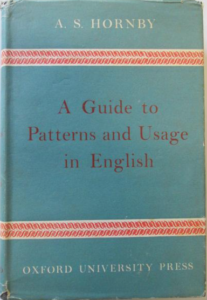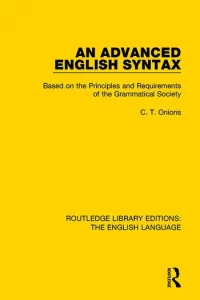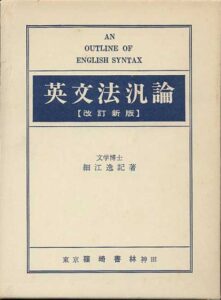People who have studied English for a relatively long time in school find it extremely challenging to actually speak it. On the other hand, it is said that Koreans find it relatively easy to learn Japanese. Despite a very short period, I have memories of self-learning Japanese and reading elementary school textbooks. There could be various reasons why English is particularly difficult to use, but the most challenging obstacle is likely the difference in word order.
Expressing English words in the order we think might be completely incomprehensible to native English speakers. This is due to the difference in word order, and scholars studying this aspect refer to it as Syntax.
At one point, the core of English grammar was considered to be the five-pattern sentence. One of the old English grammar textbooks in Korea, such as ‘Seongmun Comprehensive English,’ was also structured based on these five patterns. Here, the term ‘pattern’ refers to the way English is structured, ultimately teaching the order in which words are used.
In this context, let’s explore some traditional methods of teaching word order and the single-pattern word order that we emphasize, addressing the curiosity of the 5W1H.
Table of Contents
English Syntax
People who speak European languages find it relatively easy to acquire English because their language structure is relatively similar to English. However, for those who speak geographically or linguistically distant languages like Japanese and Korean, English can be very challenging.
Recognizing that there are standardized patterns when learning such a language would have been a significant help in English language learning. In fact, there is hardly anyone who learned English in school a long time ago and does not know the five patterns of English sentences.
However, the five patterns are not absolute in English language learning. Even among English scholars during the same period, there were diverse opinions. Some went further to propose seven patterns, and others even advocated up to 25 patterns. For example, A. S. Hornby from the UK presents 25 patterns by categorizing verb patterns in his work ‘Guide to Patterns and Usage in English.’

Five Patterns Formed by Four Constituent Elements
The most familiar five-pattern sentence, contrary to what we might assume, originated not from a Japanese linguist but from a British linguist and lexicographer, C. T. Onions. Charles T. Onions (1873-1965) was a renowned lexicographer in English linguistics, known as the editor of ‘The New English Dictionary’ (1884-1928). His linguistic contributions, particularly in English sentence structure, had a significant impact on English education in Japan, as speculated.

In his book ‘An Advanced English Syntax,’ C. T. Onions organized English expressions into “five forms of predicates” or “five sentence patterns.” This concept of five patterns was introduced to Japan by Itsuki Hosoe(1917), gaining rapid penetration into Japanese school grammar and establishing itself as an essential element in Japanese English education. Through this process, it seems to have influenced early English education in Korea as well.

As commonly known, according to these five patterns, an English sentence is divided into five sentence structures based on four sentence elements: subject (S), verb (V), complement (C), and object (O). Depending on their positions, the object and complement may be referred to as indirect object (IO), direct object (DO), or objective complement (OC). These four constituent elements create five different patterns, hence referred to as the five patterns.
Pattern 1 – Complete Intransitive Verb (S + V)
Pattern 2 – Incomplete Intransitive Verb (S + V + S·C)
Pattern 3 – Complete Transitive Verb (S + V + O)
Pattern 4 – Including Dative Verb (S + V + I·O + D·O)
Pattern 5 – Incomplete Transitive Verb (S + V + O + O·C)
Seven Patterns Composed of Five Sentence Elements
However, recently, the argument that the five patterns alone cannot explain all English expressions has gained more credibility, and the seven-pattern English pattern has become the foundation of recent middle school English education in Korea. Compared to the five patterns, the seven patterns include an additional adverb (A) to the four sentence elements (subject, verb, object, complement) of the five patterns. It can be summarized as follows:
Pattern 1: S + V + (A)
Pattern 2: S + V + O + (A)
Pattern 3: S + V + C + (A)
Pattern 4: S + V + A + (A)
Pattern 5: S + V + O + O + (A)
Pattern 6: S + V + O + C + (A)
Pattern 7: S + V + O + A + (A)
To understand the seven patterns, one must grasp the concept of essential adverbial phrases. Traditionally, adverbial phrases have been considered incapable of playing a crucial role in a sentence. However, in some sentences, without an adverbial phrase, the meaning cannot be conveyed properly.
Therefore, the sole concept that expands the English pattern from the five patterns to the seven patterns is the essential adverb (required adverb).
The essential adverb is literally an adverbial phrase that performs an essential function in the sentence structure. For those who have learned the sentence structure of the five patterns and encountered English sentences through it, the concept of essential adverbs may be unfamiliar. This is because adverbs are generally considered modifiers and are believed not to influence the sentence structure.
However, in sentences like ‘He is in the room,’ the absence of the adverbial phrase ‘in the room’ makes the expression incomplete. As explained in the principle of ‘Curiosity Resolution,’ just ‘He is’ does not resolve the curiosity.
In this sentence, ‘in the room’ is formally a prepositional phrase and functionally an adverbial phrase. According to strict English grammar, it is undoubtedly an adverbial phrase. However, if this expression is omitted, the sentence becomes both semantically and formally incomplete. Let’s consider another example:
‘He placed my bag in the closet.’
In this sentence, without ‘in the closet,’ the expression is complete according to the grammar of the five patterns, but it becomes semantically incomplete. Furthermore, the sentence cannot be explained as a five-pattern sentence.
Only One Pattern English based on 5W1H with 8 Sentence Elements
In English, the most crucial elements are the subject and the verb. Therefore, the most important training in using English is to grasp at once. Once the subject and verb are understood in English, half the battle is already won. This aspect is not different from the concepts of the aforementioned 5-pattern and 7-pattern.
On the other hand, this theory combines the object and complement in the 5-pattern theory and lumps the remaining elements into adverbs or essential adverbs in the 7-pattern sentence.
We differentiate English sentences into 8 elements based on the 5W1H principles rather than the 4 or 5 elements, as traditionally understood. Although the number of elements has increased, the sentence pattern can still be compressed into a single pattern.
This sentence pattern is further simplified by organizing the elements according to the principle of curiosity resolution. In essence, after stating the subject and verb in English, the listener, following our sentence structure, develops curiosity based on the verb. English expressions are then written to resolve this curiosity in a sequential order. Summarized as one sentence pattern:
Subject(S) + Verb(V) + (Who?) + (What?) + (Where?) + (Why?) + (How?) + (When?)
Fortunately, the order following the subject and verb aligns with the journalistic principles known as the 5W1H (Who, What, Where, Why, When, How). While exceptions exist, generally, English expressions adhere to this sequence. Understanding this principle is essential to recognizing exceptions.
We may also refer to this principle as the ‘Curiosity Resolution of the 5W1H.’ In summary, English, after stating the subject and verb, proceeds to resolve curiosity in the order of (However) Who?/To Whom? + (However) What? + (However) Where? + (However) Why? + (However) How? + (However) When?
For instance, to express “내일 아침 저의 사무실에서 그 일에 대하여 그 사람이 잘 알아들을 수 있도록 제가 말하겠습니다” in English, we first organize the Korean sentence based on the :
Subject/ I + Verb/ will talk + (Who?) to him + (What?) about that matter + (Where?) in my office + (Why?) to be understood well + (How?) tomorrow morning
Now, let’s transform this into English. While there isn’t a single correct answer, according to our , one possible expression could be:
“I will talk to him about that matter in my office to be understood well tomorrow morning.”
While not a perfect sentence, it conveys the intended meaning. To express this more accurately and efficiently, one needs to enhance vocabulary and the ability to construct complex sentences using conjunctions. Additionally, a diverse understanding of verb usage is crucial, as the sequence of elements following the subject and verb changes based on the verb.
The 25 Patterns of English
As previously mentioned, the British linguist A. S. Hornby in ‘Guide to Patterns and Usage in English’ categorizes verb patterns into 25 types (which further subdivides into 53 sentence patterns). While it would be meaningful to learn these patterns one by one, memorizing so many patterns does not seem easy. Therefore, I share the following article as a reference for examining each of these patterns.


답글 남기기